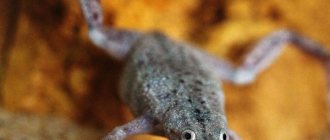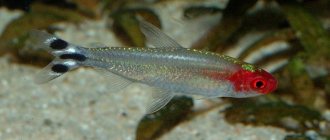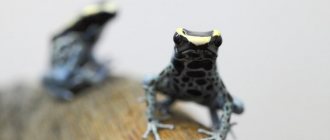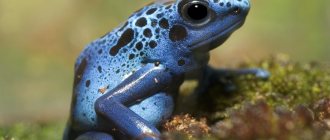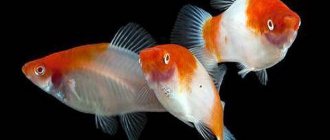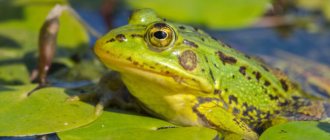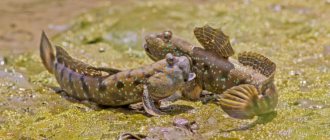Should an aquarium contain only beautiful and graceful fish? Of course not. Aquarium inhabitants can be very different. Proof of this is the red-bellied firebird, which is often settled in an artificial reservoir of water. This is a small frog with an unusual color - a red belly with an amazing pattern of black spots merging with each other. According to popular belief, this small frog lives in the craters of volcanoes on earth. Another name for the red-bellied firebird is kumka or unca, given by the sounds that the male frog makes during the breeding season.
Natural habitat
The red-bellied firebird lives in Eastern and Central Europe. Preference is given to shallow reservoirs with standing water or very slow currents, where the water warms up well under the sun's rays. The toaded toad feels especially comfortable in small rivers with silt at the bottom, ditches and swampy areas.
The frog loves duckweed and large amounts of river vegetation. Rare, but found in creeks with semi-flowing water. In search of more comfortable living conditions, the toaded toad can leave one body of water and move to another, making a journey overland about 700 meters long.
The red-bellied firebird lives most of its life in water; it is on land extremely rarely, for a short period of time.
The activity of the frog occurs at atmospheric temperatures in the range of +10° – +30°C.
From the beginning of October, less often in November, depending on solar activity, the frog goes into hibernation. During this period, she is on the shore, hiding in abandoned rodent burrows or sand pits.
If a frog lives near a populated area, during wintering it can be found under various buildings. In addition, toads often crawl into basements and cellars for the winter. The duration of hibernation is approximately 150 days, until stable warm weather sets in. 2 weeks after the frog wakes up, mating season begins.
In the wild, the toad eats small invertebrate animals and likes to pamper itself with beetles, worms, and dragonflies. The daily menu depends entirely on the habitat. Red-bellied firebirds can eat their fellow tribesmen if they are smaller in size.
Representatives of this species living in an aquarium can be fed:
- bloodworm;
- tubifex;
- crickets;
- Daphnia;
- mealworms.
The toad will readily consume specialized industrial food, which can be purchased at pet stores. When living in captivity, it is recommended to feed the frog with vitamin and mineral supplements. It is important to maintain a proper diet. Young individuals are fed every day, and adult frogs that have reached sexual maturity, once every few days.
Feeding
Organizing the nutrition of these amphibians does not pose any particular problems.
The food can be bloodworms, crickets, cockroaches, tubifex, a small worm (mealworm, for example). Once a month, experts recommend giving a commercial vitamin concentrate for amphibians. This periodic addition to the daily diet helps maintain the animal’s immunity. Adults can be given food every other day. Young animals are fed the same thing, but the food fraction should be smaller and feeding should be done daily. It is advisable to add calcium powder to your food at this stage. Crushed eggshells work best.
Description of appearance
The red-bellied firebird is small in size : its body reaches 6 cm, no more. Females are usually slightly larger than males. The toad has a beautiful, specific color, thanks to which it has become so popular among aquarists and terrarium keepers. The upper part of the frog's body is painted in a dark, almost black color, diluted with spots of green in different shades.
What is unusual about the frog is is red; the spots on it can be located either separately or merge with each other. The color of the spots is black with purple tints; there are numerous white inclusions over their entire surface. In the wild, the red color in color is a warning to other animals and indicates impending danger. The red belly of this frog signals that it should not be eaten as it is poisonous.
The frog's skin secretes the substance frinolicin through its pores, which is a strong toxin that is fatally poisonous to animals seeking to encroach on the life of the frog. This small frog is unique in many ways; for example, only its hind legs are equipped with membranes Another unique feature of the amphibian is its eyes : the pupils have a completely atypical shape - they are triangular, similar to hearts.
Interesting facts about the animal
Unka differs from its relatives in interesting features:
- The pattern on the abdomen of each frog is unique. It is impossible to find two fire toads with the same arrangement and size of patterns and spots.
- Fire toads have a special anatomical structure of the tongue - its entire lower part is attached to the oral cavity. Therefore, unlike many other species of frogs, the fire-bellied toad cannot capture food with its tongue.
- Thanks to this structure of the tongue, fire-bellied toads cannot croak like their relatives. Instead, they make a sound that most closely resembles a drawn-out “oooh” sound. Because of this feature, the voices of these amphibians are also called unki or ukami.
- These small frogs move poorly on the ground; the length of their feet is almost equal to the length of their lower leg.
- Another interesting feature of the Unca is the absence of membranes on its front paws. This “gadget” is only found on the amphibian’s hind legs.
- The frog's pupils are unusual: their shape is not round or oval, but triangular.
- The toad has no eardrums or parotids (parotid venom glands). Therefore, this amphibian hears only low-frequency sounds. To do this, the toad has to press its ear to the ground.
The red-bellied firebird is a miniature frog with original eyes and a ringing voice. The number of these beautiful amphibians is steadily decreasing from year to year.
To avoid their complete destruction, man should reconsider his attitude towards nature and create comfortable living conditions for the Unk.
Creating comfortable conditions in an aquarium or terrarium
The red-bellied firebird will feel quite comfortable in a terrarium if all the necessary conditions are created.
Fire-bellied frogs are long-lived frogs, and if they are kept in an aquarium, their life cycle is, on average, from 10 to 15 years, but they often live much longer.
Toadstools are only suitable for keeping in a species aquarium. Placing them with other inhabitants in a terrarium is strictly prohibited, since any animal living in the same territory as the toad will soon die due to poisoning. In order for the fire toad to live comfortably in captivity, it needs to create certain conditions:
- The volume of the terrarium must be at least 30 liters. It is imperative to arrange a piece of land in a tank with a water depth of no more than 6 cm.
- Heating the bottom is a mandatory condition, without which the toaded toad cannot live. The optimal temperature is between +20° and +26°C at night; during the day it is recommended to reduce it to +16°C – +20°C.
- Soil - must consist of several layers. The first is drainage, then pour a thin layer of soil and then lay down moss. The land area should be covered with sphagnum.
You can place a small raft on the water so that the frog can crawl onto it. The terrarium must have dense vegetation. The best plant options are cryptocoryne and anubias. Plants with a root system should be planted in pots. It is recommended to place free-floating plants in the terrarium, for example, elodea, salvinia, and richia.
Content
Dimensions of the home . Indeed, for a frog to exist at home, it needs an aquaterrarium with a water/land ratio of 1:1. The minimum volume of an aquaterrarium for 1 individual is 5 liters. Frogs are often kept in pairs or in groups of 3–4. Of course, in this case the frog’s home must be large in volume and area.
Heating . To ensure a satisfactory microclimate, the terrarium is equipped with a heating device, which can be an ordinary incandescent lamp located above the shore at a height safe for the animal. There are options for placing a special thermal mat or flexible thermal cord under the bottom of the aquaterrarium.
The optimal air temperature should be from +20 to +25 degrees during the daytime. At night you can lower the temperature slightly to +18°C. The water temperature in the “wet zone” should be maintained at 18–21 degrees above zero.
Summer daylight hours should be at least 12 hours.
Bottom organization . Fine gravel or river sand is usually used as soil in a reservoir. As for the soil on land, it is usually laid in layers: a layer of gravel on the bottom and earth on top. To create conditions close to the natural biotope, moss and other low plants are planted in the ground. You can do without land vegetation if you “make” land using coconut crumbs.
Aquatic vegetation is desirable. You can plant Echinodorus or Cryptocoryne. The presence of free-floating plants (pistia or salvinia, for example) is allowed on the surface of the water.
It also makes sense to make a small floating platform in a pond, which the toaded toads will happily climb onto.
Reproduction of the toad
Due to its long life cycle, the red-bellied toad matures rather slowly. Puberty occurs only at 3 and sometimes 4 years from birth. The period when adult individuals are ready to reproduce offspring stretches for a long time - all summer. If a female lives on the shore of a shallow body of water, she lays eggs on plant leaves and algae.
At one time, the red-bellied toad lays approximately 300 eggs.
The incubation period lasts approximately 10 days, after which tadpoles emerge. The size of newborn frogs is no more than 3-5 mm, the fin on the tail is wide, thanks to which tadpoles can move, and they do this over quite long distances. A born red-bellied firebird is considered a tadpole until it reaches the age of 3 months.
The mating season of toaded firebirds is very interesting. The males desperately fight for the female’s attention and do it extremely funny - they sit down and start hitting the bottom with their paws, raising a lot of splashes and silt. Thus, they show how strong and worthy the heart of the chosen female is. In addition, the male demonstrates that he is the master of his territory and is ready to zealously defend it from the encroachments of other frogs.
Organization of wintering
Preparations for the winter period should begin in December. For this:
- from mid-November, the duration of the photoperiod and the temperature in the aquaterrarium are gradually reduced. Until the beginning of December, the artificial heater is turned off completely;
- after another 7 days, the amphibian is moved from the terrarium to a separate container, which is filled with peat - sphagnum;
- The container is placed in a cool place where the temperature does not exceed +15 degrees. After three days, the toad is transferred to the refrigerator and left at a temperature of +5-8 degrees.
The hibernation period lasts about two months.
Important! It is necessary to bring the toad out of hibernation strictly in the reverse order.
Features of behavior and character
Red-bellied firebirds are moderately calm by nature. However, it is impossible to say how they will behave with their neighbors in the terrarium, since it is impossible to introduce other inhabitants due to the frog’s toxicity. Little toads relate fairly evenly to representatives of their own species. Aggressive behavior and character traits can only appear during reproduction, which is explained by the protection of their territory and the female.
Red-bellied frogs are very interesting to watch. Representatives of this species have a rather specific jaw structure and anatomical features of the tongue. In this regard, they eat their prey unusually, or rather differently from other frogs. Fire-bellied toads do not stick out their tongues, trying to catch prey, but open their mouths wide, actually swallowing them.
If the fire-bellied toad feels danger, at the sight of an enemy it abruptly turns over on its back, showing off its red belly in all its glory. Not a single animal in the wild would dare to come close to an amphibian at the sight of a red color, signaling an extreme degree of toxicity.
Natural enemies
Thanks to its poisonousness, the frog can boast that it defends itself from predators. A fairly large number of animals hunt for fire toads.
Among the reptiles are marsh turtles, grass snakes, and vipers. Newts, herons, storks, ducks, and rodents are not averse to feasting on frogs. The bright color of the abdomen makes it possible to scare away enemies, and those who are not afraid to come closer may receive burns or die from poison.
Is it worth getting a red-bellied firebird?
It is difficult to purchase this small, cute frog for your home terrarium. This species is quite rare and is listed in the Red Book. Therefore, biologists carefully monitor this species of amphibian and do everything possible to preserve this population.
Frogs are quite unpretentious and flexible, not requiring the creation of specific living conditions. Nevertheless, it is recommended to start them only for those people who have some experience in the terrarium field.
Toaded toads are characterized by high physical endurance and are not susceptible to any diseases, but only if all the necessary conditions for their maintenance are created. The frog's health may deteriorate due to poor nutrition and temperature disturbances, as a result of which the frog will become lethargic and apathetic.
It is a pleasure to watch fire-bellied frogs, since they are unique, unusual frogs in every way, having an atypical appearance and very interesting behavior. If you manage to acquire a red-bellied firebird, it will be a peaceful pet, the only drawback of which is that you cannot play with it without protective gloves.
Notes
- Kuzmin S. L.
Amphibians of the former USSR / Reviewers: Academician of the Russian Academy of Sciences E. I. Vorobyova, Ph.D. n. S. M. Lyapkov. - M.: Partnership of Scientific Publications KMK, 2012. - P. 106. - 1000 copies. — ISBN 978-5-87317-871-1. - Source of Russian names: Ananyeva N. B., Borkin L. Ya., Darevsky I. S., Orlov N. L.
Five-language dictionary of animal names. Amphibians and reptiles. Latin, Russian, English, German, French. / under the general editorship of academician. V. E. Sokolova. - M.: Rus. lang., 1988. - P. 51. - 10,500 copies. — ISBN 5-200-00232-X. - ↑ 1 2 3 Frost, Darrel R.
Bombinatoridae
(unspecified)
.
Amphibian Species of the World: an Online Reference.
Version 6.0 . American Museum of Natural History (2014). - ↑ 1 2
Laurie J. Vitt und Janalee P. Caldwell:
Herpetology: An Introductory Biology of Amphibians and Reptiles.
Academic Press, 2013, ISBN 978-0123869197, Page 475-476. - Amphibia Web.
Bombinatoridae
(undefined)
.
Provides information on amphibian declines, natural history, conservation, and taxonomy
(2017).
Photo of red-bellied firebird
Venom of tailless amphibians
In general, the venom of frogs and toads is primarily a protein, which includes highly active compounds, enzymes, catalysts, etc. It contains chemicals that act on the nervous system, mainly the peripheral one, as well as proteins that cause the destruction of erythrocytes - red blood cells. The poison contains substances that selectively act on the heart.
Interestingly, these toxins have a special biological significance for the amphibians themselves. Cocoa, which has a bright, provocative color that scares away predators, has an exceptionally strong poison in its effect. Frogs, which are quite closely related to cocoa, but have a calm, inconspicuous coloration, generally lack a poisonous secretion.
The presence, or, conversely, absence of certain substances in the skin of frogs depends on the location and conditions of their habitat. For example, amphibians that spend a lot of time on land have chemical components that can protect them in a terrestrial environment, unlike animals that prefer a longer aquatic lifestyle. It is interesting that the suprascapular glands of toads contain components in the venom that are cardiotoxic, i.e. acting primarily on the heart. Apparently, this feature of their poison is due to their terrestrial lifestyle and serves as protection against attacks by predators. Even snakes will not eat a brightly colored toad, and if they grab it, they will try to throw it back. This is despite the fact that many snakes have their own venom glands and have a certain natural immunity to venom.
The poison of tiny leaf climbers is sometimes dangerous for the frogs themselves. It is so strong in its effect that, if it accidentally gets into a scratch on their skin, it can kill the frog itself. Apparently, the frogs that produce it are not exposed to the poison under normal living conditions. This is explained by the fact that the cells producing the poison are well isolated from other tissues and the toxin cannot spread throughout the body.
There are practically no antidotes against leaf climber poison. The skin of an adult frog, less than 50 mm long, contains a very toxic substance, batrachotoxin, first isolated from the venom of the Colombian frog. Batrachotoxin is a chemical found in the skin venom of five species of frogs native to southern Central America and northwestern South America. Currently, scientists have been able to artificially obtain this substance in the laboratory, and its toxic properties are not inferior to natural ones.
Housing
Toadstools are best kept at room temperature between 18º and 24ºC. Fire toads should avoid temperatures above 54ºC, as it can cause “temperature stress” in the animal. If you keep a toad in the house, there is no need to use an additional heat source.
The source of ultraviolet radiation has a beneficial effect on the health of the toad and helps in calcium metabolism. A photoperiod of 12-14 hours works well for most fire toads.
The toaded toad can be safely kept in a simple aquarium or in a well-equipped vivarium with a natural environment. The doors in the fence must close very tightly, since the toad can escape even through a very small hole. In the room where the frog lives, you need to equally distribute land and water.
Since toaded toads are not particularly good swimmers, the water level should be low: 10 cm for large toaded toads, 5 cm for all other species. Plants, live or artificial, should be placed in water so that the toad can easily use them to get out of its “pond.” The water should be changed frequently, even if you use filter devices. It must not contain chlorine or chloramine. Melt water is well suited for these purposes. On land, you need to organize shelters from gravel, pebbles and peat moss. The design of the home should include an easy system for cleaning and replacing water.

